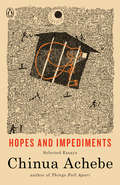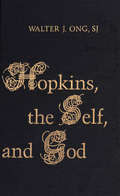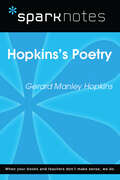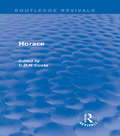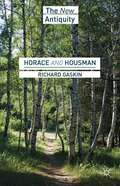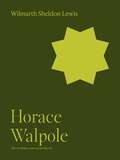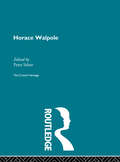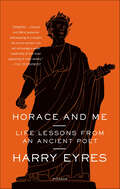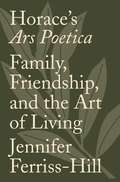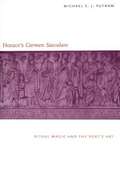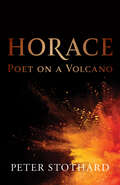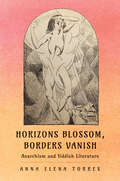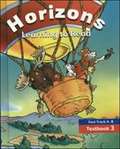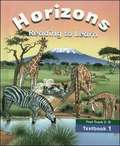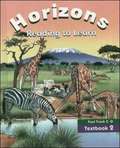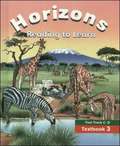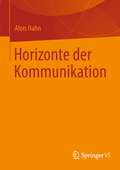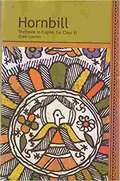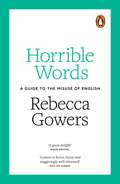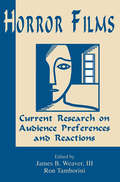- Table View
- List View
Hopes and Impediments: Selected Essays
by Chinua AchebeOne of the most provocative and original voices in contemporary literature, Chinua Achebe here considers the place of literature and art in our society in a collection of essays spanning his best writing and lectures from the last twenty-three years. For Achebe, overcoming goes hand in hand with eradicating the destructive effects of racism and injustice in Western society. He reveals the impediments that still stand in the way of open, equal dialogue between Africans and Europeans, between blacks and whites, but also instills us with hope that they will soon be overcome.From the Trade Paperback edition.
Hopkins Self and God
by Walter J. OngIn these studies Professor Ong explores some previously unexamined reasons for Hopkins' uniqueness, including unsuspected connections between nineteenth-century sensibility and certain substructures of Christian belief.General Manley Hopkins was not alone among Victorians in his attention to the human self and to the particularities of things in the world around him, where he savoured the 'selving or 'inscape' of each individual existent. But the intensity of his interest in the self, as a focus of exuberant joy as well as sometimes of anguish, both in his poetry and his prose, marks him out as unique even among his contemporaries. In these studies Professor Ong explores some previously unexamined reasons for Hopkins' uniqueness, including unsuspected connections between nineteenth-century sensibility and certain substructures of Christian belief.Hopkins was less interested in self-discovery or self-concept than in what might be called the confrontational or obtrusive self - the 'I,' ultimately nameless, that each person wakes up to in the morning to find simply there, directly or indirectly present in every moment of consciousness. Hopkins' concern with the self grew out of a nineteenth-century sensibility which was to give birth to modernity and postmodernity, and which in his case as a Jesuit was especially nourished by the Spiritual Exercises of St Ignatius Loyola, concerned at root with the self, free choice, and free self-giving. It was also nourished by the Christian belief in the Three Persons in One God, central to Hopkins' theology courses and personal speculation, and very notable in the Special Exercises. Hopkins appropriated and intensified his Christian beliefs with new nineteenth-century awareness: he writes of the 'selving' in God of the Father, the Son, and the Holy Spirit. Hopkins' pastoral work, particularly in the confessional, dealing directly with other selves in terms of their free decisions, also gave further force to his preoccupation with the self and freedom. 'What I do,' he writes, 'is me.'Besides being concerned with the self, the most particular of particulars and the paradigm of all sense of 'presence,' the Spiritual Exercises in many ways attend to other particularities with an insistence that has drawn lengthy and rather impassioned commentary from the postmodern literary theorist Roland Barthes.Hopkins' distinctive and often precocious attention to the self and freedom puts him theologically far ahead of many of his fellow Catholics and other fellow Victorians, and gives him his permanent relevance to the modern and postmodern world.
Hopkins's Poetry (SparkNotes Literature Guide Series)
by SparkNotesHopkins's Poetry (SparkNotes Literature Guide) by Gerald Manley Hopkins Making the reading experience fun! Created by Harvard students for students everywhere, SparkNotes is a new breed of study guide: smarter, better, faster.Geared to what today's students need to know, SparkNotes provides:chapter-by-chapter analysis explanations of key themes, motifs, and symbols a review quiz and essay topics Lively and accessible, these guides are perfect for late-night studying and writing papers.
Horace (Routledge Revivals)
by C.D.N. CostaTwo thousand years after his death Horace is still recognised as a unique poet, having exerted marked influence on later European literature. This collection, first published in 1973, explores the different aspects of Horace’s poetic achievement in his main works: the Odes, Epistles¸ Satires and Ars Poetica. The essays, written by internationally-known scholars, include a discussion of the three worlds of the Satires, and a study of Horace’s poetic craft in the Odes – his greatest technical accomplishment. The final chapter is devoted entirely to Horace’s reputation in England up to the seventeenth century as ‘The Best of Lyrick Poets’, and concentrates on the many English translations which he inspired. The expert criticism is illustrated throughout by English translations from the original Latin texts. Horace will appeal to students and scholars of Latin poetry alike, as well as to those interested in the reception of classical literature throughout European history.
Horace And Housman
by Richard GaskinThe lyric poems of Horace and Housman are two enigmatic bodies of work that have much in common, and a close reading of each poet's writings can illuminate the other's. This is the first book to provide a detailed, critical comparison between these two poets, and also the first to make use of Housman's unpublished lectures on Horace.
Horace Walpole (The A. W. Mellon Lectures in the Fine Arts #9)
by Wilmarth Sheldon LewisAn illuminating biographical study of the eighteenth-century English man of letters and patron of the artsHorace Walpole (1717–1797) was a collector, printer, novelist, arbiter of taste, and renowned writer of letters. In this book, eminent scholar Wilmarth Sheldon Lewis provides an unprecedented look at the life and work of one of England’s greatest men of letters. Lewis sheds light on Walpole’s relationships with his family and friends, his politics, his writings and printmaking activities, and his correspondence. Featuring portraits of Walpole, his relatives, and friends; images of Walpole's sketches and manuscripts; pages from books printed at Walpole’s Strawberry Hill Press; and views and plans of Strawberry Hill, the house, its rooms and furnishings, and its grounds, and accompanied by Lewis’s extensive annotations, this book provides an invaluable history of an extraordinary man.
Horace Walpole: The Critical Heritage (Critical Heritage Ser.)
by Peter SaborFirst Published in 1995. Routledge is an imprint of Taylor & Francis, an informa company.
Horace and Me: Life Lessons from an Ancient Poet
by Harry EyresA wise and witty revival of the Roman poet who taught us how to carpe diemWhat is the value of the durable at a time when the new is paramount? How do we fill the void created by the excesses of a superficial society? What resources can we muster when confronted by the inevitability of death? For the poet and critic Harry Eyres, we can begin to answer these questions by turning to an unexpected source: the Roman poet Horace, discredited at the beginning of the twentieth century as the "smug representative of imperialism," now best remembered—if remembered—for the pithy directive "Carpe diem." In Horace and Me: Life Lessons from an Ancient Poet, Eyres reexamines Horace's life, legacy, and verse. With a light, lyrical touch (deployed in new, fresh versions of some of Horace's most famous odes) and a keen critical eye, Eyres reveals a lively, relevant Horace, whose society—Rome at the dawn of the empire—is much more similar to our own than we might want to believe. Eyres's study is not only intriguing—he retranslates Horace's most famous phrase as "taste the day"—but enlivening. Through Horace, Eyres meditates on how to live well, mounts a convincing case for the importance of poetry, and relates a moving tale of personal discovery. By the end of this remarkable journey, the reader too will believe in the power of Horace's "lovely words that go on shining with their modest glow, like a warm and inextinguishable candle in the darkness."
Horace's Ars Poetica: Family, Friendship, and the Art of Living
by Jennifer Ferriss-HillA major reinterpretation of Horace's famous literary manualFor two millennia, the Ars Poetica (Art of Poetry), the 476-line literary treatise in verse with which Horace closed his career, has served as a paradigmatic manual for writers. Rarely has it been considered as a poem in its own right, or else it has been disparaged as a great poet's baffling outlier. Here, Jennifer Ferriss-Hill for the first time fully reintegrates the Ars Poetica into Horace's oeuvre, reading the poem as a coherent, complete, and exceptional literary artifact intimately linked with the larger themes pervading his work.Arguing that the poem can be interpreted as a manual on how to live masquerading as a handbook on poetry, Ferriss-Hill traces its key themes to show that they extend beyond poetry to encompass friendship, laughter, intergenerational relationships, and human endeavor. If the poem is read for how it expresses itself, moreover, it emerges as an exemplum of art in which judicious repetitions of words and ideas join disparate parts into a seamless whole that nevertheless lends itself to being remade upon every reading.Establishing the Ars Poetica as a logical evolution of Horace's work, this book promises to inspire a long overdue reconsideration of a hugely influential yet misunderstood poem.
Horace's Carmen Saeculare: Ritual Magic and the Poet's Art
by Michael C. J. Putnam"This is the first book devoted to Horace's Carmen Saeculare, a poem commissioned by Roman emperor Augustus in 17 B. C. E. for choral performance at the Ludi Saeculares, the Secular Games. The poem is the first fully preserved Latin hymn whose circumstances of presentation are known, and it is the only lyric by Horace that we can be certain was first presented orally. Michael C. J. Putnam offers a close and sensitive reading of this hymn shedding new light on the richness and virtuosity of its poetry, on the many sources Horace drew on, and on the poem's power and significance as a public ritual.
Horace: Image, Identity, and Audience
by Randall L. McNeillTraditional views of Horace seek to present the poet as a consistent, vivid personality who stands behind and orchestrates the diverse "Horatian" writings that have come down to us. In recent years, however, an alternate tradition suggests that there may be many Horaces, that his work is more productively read as the constant invention of rhetorical techniques sensitively attuned to the requirements of different situations and audiences. As Randall L. B. McNeill argues, any sense that readers have of the "real" Horace is clearly deceptive; Horace offers us no unguarded self-portrait, but rather a number of consciously developed characterizations to suit diverse audiences, whether patron, peers, or the public.Horace: Image, Identity, and Audience provides a wide-ranging analysis of Horace's use of self-presentation in his poetry: in his portrayal of his relationships with his patron Maecenas and with his larger readership as a whole; in his discussion of the craft of poetry and his own identity as a poet; and in his handling of contemporary Roman political events in the light of his assumed role as critic of his own society. McNeill uncovers the techniques Horace uses to depict the intricacies of his personal existence; in the book's conclusion, he explores how similar techniques were adapted by later poets such as Ovid. This volume will interest scholars of Horace, Latin poetry, rhetoric, as well as those interested in the cultural studies aspect of persona and identity.
Horace: Poet on a Volcano (Ancient Lives)
by Peter StothardA biography of Horace, one of the most popular poets from antiquity, revealing the little-known man behind his famous lines &“Peter Stothard is a master of modern writing about ancient Rome, of vividly bringing to life its poetry and its poets.&”—Mary Beard Quintus Horatius Flaccus (65–8 BCE) wrote some of ancient Rome&’s greatest poetry, melding languages and cultures with youthful ideals and a realist&’s recognition of the dictatorial world around him. Horace is famed for his fine phrases, lyric sex, and guidance on how to live, but he was a poet maddened by war, and many of his most self-revealing poems have rarely been read. He could be sublime and obscene, amusing and abusive, a model of moderation and anything but. In this book, the first modern retelling of Horace&’s life, Peter Stothard follows the poet from his birth as the son of a formerly enslaved father through his rise to the highest circles of Roman society. He shines a light on how shattering experiences in the war to save Rome&’s republic shaped the loyal servant and revolutionary artist he became. With astute scholarship and sympathy, Stothard follows Horace&’s rise from humble beginnings to the social and political heights of the autocracy he had fought to prevent.
Horizons Blossom, Borders Vanish: Anarchism and Yiddish Literature
by Anna Elena TorresA bold recovery of Yiddish anarchist history and literature Spanning the last two centuries, this fascinating work combines archival research on the radical press and close readings of Yiddish poetry to offer an original literary study of the Jewish anarchist movement. The narrative unfolds through a cast of historical characters, from the well known—such as Emma Goldman—to the more obscure, including an anarchist rabbi who translated the Talmud and a feminist doctor who organized for women&’s suffrage and against national borders. Its literary scope includes the Soviet epic poemas of Peretz Markish, the journalism and modernist poetry of Anna Margolin, and the early radical prose of Malka Heifetz Tussman. Anna Elena Torres examines Yiddish anarchist aesthetics from the nineteenth-century Russian proletarian immigrant poets through the modernist avant-gardes of Warsaw, Chicago, and London to contemporary antifascist composers. The book also traces Jewish anarchist strategies for negotiating surveillance, censorship, detention, and deportation, revealing the connection between Yiddish modernism and struggles for free speech, women&’s bodily autonomy, and the transnational circulation of avant-garde literature. Rather than focusing on narratives of assimilation, Torres intervenes in earlier models of Jewish literature by centering refugee critique of the border. Jewish deportees, immigrants, and refugees opposed citizenship as the primary guarantor of human rights. Instead, they cultivated stateless imaginations, elaborated through literature.
Horizons: Learning To Read - Fast Track A-B Textbook 3
by Siegfried Engelmann Owen Engelmann Karen Lou Seitz DavisLanguage Arts/Reading Textbook
Horizons: Read to Learn (Fast Track C-D; Textbook 1)
by Siegfried Engelmann Susan Hanner Owen Engelmann Karen L. DavisHorizons is an innovative program for teaching reading that provides solid, systematic instruction using proven Direct Instruction techniques, updated with current research on beginning reading. A unique instructional sequence incorporates word attack, story reading, comprehension exercises, spelling and independent work on a daily basis to ensure success. Levels A, B, and Fast Track A-B build a solid foundation for fluency and comprehension by systematically teaching phonemic awareness and phonics. Fast Track C-D expands key decoding and vocabulary skills while developing higher order thinking and comprehension strategies.
Horizons: Reading To Learn - Fast Track C-D
by Siegfried Engelmann Susan Hanner Owen Engelmann Karen L. DavisHorizons is an innovative program for teaching reading that provides solid, systematic instruction using proven Direct Instruction techniques, updated with current research on beginning reading. A unique instructional sequence incorporates word attack, story reading, comprehension exercises, spelling and independent work on a daily basis to ensure success. Levels A, B, and Fast Track A-B build a solid foundation for fluency and comprehension by systematically teaching phonemic awareness and phonics. Fast Track C-D expands key decoding and vocabulary skills while developing higher order thinking and comprehension strategies.
Horizons: Reading to Learn (Fast Track C-D, Textbook 3)
by Siegfried Engelmann Susan Hanner Owen Engelmann Karen L. DavisHorizons is an innovative program for teaching reading that provides solid, systematic instruction using proven Direct Instruction techniques, updated with current research on beginning reading. A unique instructional sequence incorporates word attack, story reading, comprehension exercises, spelling and independent work on a daily basis to ensure success. Levels A, B, and Fast Track A-B build a solid foundation for fluency and comprehension by systematically teaching phonemic awareness and phonics. Fast Track C-D expands key decoding and vocabulary skills while developing higher order thinking and comprehension strategies.
Horizonte der Kommunikation
by Alois HahnÜber Kommunikation ist viel kommuniziert worden. Watzlawick schreibt sogar, man könne nicht nicht kommunizieren. Die hier vorgelegte Aufsatzsammlung vereint eine Reihe von Beiträgen, die im Laufe der Jahre in höchst unterschiedlichen Kontexten entstanden sind. Das Thema Kommunikation war oft nicht das Zentrum. Viele Texte entstanden ursprünglich auch in interdisziplinären Kolloquien. Die Arbeiten hier zusammenzufügen entspringt der Absicht, eine vorher teilweise latente Sinnlinie freizulegen. Man könnte von einer Transformation von Publikationen in Spolien sprechen. Das Hauptanliegen ist, einige bislang eher wenig behandelte Horizonte des Themas ins Auge zu fassen, Ränder sozusagen oder Sonderaspekte. Dieser Horizont erscheint bisweilen als Kaleidoskop.
Hornbill: Textbook in English (Core Course) class 11 - NCERT - 23
by National Council of Educational Research and TrainingThe Hornbill Textbook in English is a comprehensive English language textbook that aims to develop the students' reading, writing, and critical thinking skills. The textbook is divided into two parts: Reading Skills and Writing Skills. The Reading Skills section includes six chapters that introduce the students to a variety of genres, such as biography, travelogue, science fiction, essays, and poems. The Writing Skills section includes six chapters that teach the students the different forms of writing, such as letter writing, creative writing, note-taking, summarizing, and report writing. The textbook is a valuable resource for students who are interested in improving their English language skills.
Horrible Mothers: Representations across Francophone North America
by Loïc BourdeauFor too long the main narratives of motherhood have been oppressive and exclusionary, frequently ignoring issues of female identity—especially regarding those not conforming to traditional female stereotypes. Horrible Mothers offers a variety of perspectives for analyzing representations of the mother in francophone literature and film at the turn of the twenty-first century in North America, including Québec, Ontario, New England, and California. Contributors reexamine the &“horrible mother&” paradigm within a broad range of sociocultural contexts from different locations to broaden the understanding of mothering beyond traditional ideology. The selections draw from long-established scholarship in women&’s studies as well as from new developments in queer studies to make sense of and articulate strategies of representation; to show how contemporary family models are constantly evolving, reshaping, and moving away from heteronormative expectations; and to reposition mothers as subjects occupying the center of their own narrative, rather than as objects. The contributors engage narratives of mothering from myriad perspectives, referencing the works of writers or filmmakers such as Marguerite Andersen, Nelly Arcan, Grégoire Chabot, Xavier Dolan, Nancy Huston, and Lucie Joubert.
Horrible Words: A Guide to the Misuse of English
by Rebecca GowersNothing inflames the language gripers like a misplaced disinterested, an illogical irregardless, a hideous operationalisation. To purists these are 'howlers' and 'non-words', fit only for scorn. But in their rush to condemn such terms, are the naysayers missing something? In this provocative and hugely entertaining book, Rebecca Gowers throws light on a great array of horrible words, and shows how the diktats of the pedants are repeatedly based on misinformation, false reasoning and straight-up snobbery. The result is a brilliant work of history, a surreptitious introduction to linguistics, and a mischievous salute to the misusers of the language. It is also a bold manifesto asserting our common rights over English, even as it questions the true nature of style.
Horror Films: Current Research on Audience Preferences and Reactions (Routledge Communication Series)
by Iii James B. Weaver Ron TamburiniWhy do so many of us enjoy being told frightening stories? What are some of the consequences that result from such exposure? In light of the considerable popularity of horror films over the last three decades, these questions have become the focus of growing attention for many scholars. However, research on audience preferences for, and reactions to, horror films has been performed eclectically by investigators from varied theoretical and methodological backgrounds. As a result, the information has not been effectively integrated. This volume was written to address this problem and to position the study of audience responses to frightening fiction as a significant research topic.
